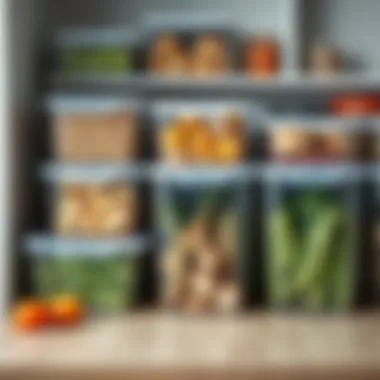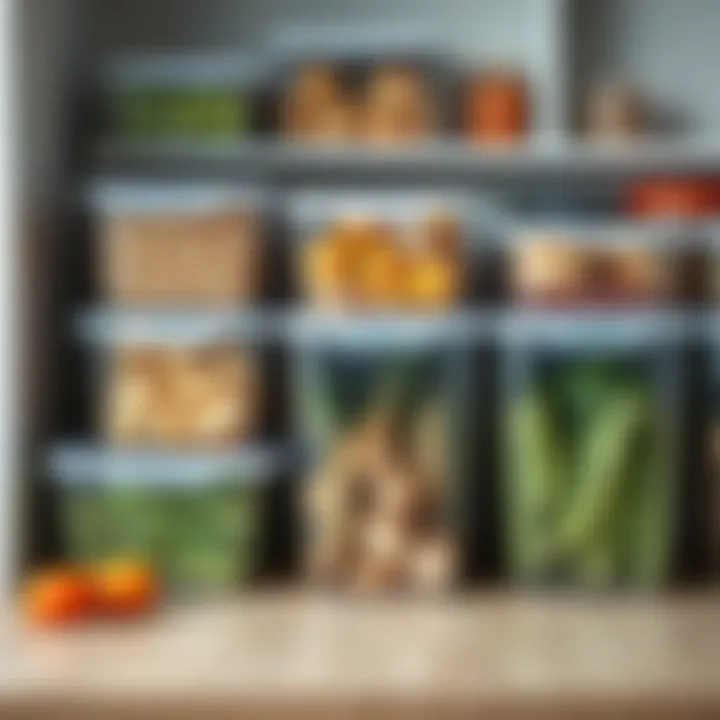Maximizing Freshness with Longer Food Storage Solutions


Intro
In today's fast-paced world, maximizing the freshness of our food has become a priority for many households. Longer food storage containers are emerging as vital tools in achieving this aim. These containers not only provide effective means of preserving food but also fit seamlessly into modern kitchen aesthetics. As we delve into the various dimensions of these innovative solutions, we will explore everything from their design and materials to practical tips for choosing the right ones for specific food items.
Understanding the importance of proper food storage requires a closer look at how technology has evolved over the years, offering us advanced options that cater to both functionality and style. This guide aims to shed light on the best practices of food storage, emphasizing the idea that the right container can significantly extend the life of ingredients, thereby minimizing waste and enhancing the overall cooking experience.
Furniture Design Trends
Current Styles and Aesthetics
Incorporating longer food storage containers within the kitchen requires a careful consideration of design trends. Contemporary kitchens often reflect an open, airy feel, and the choice of storage containers can either complement or disrupt this aesthetic. Today, sleek, minimalist designs are in vogue, with containers available in various shapes and sizes to suit any cabinet or countertop space.
Think about materials that not only perform well but also look good. Stainless steel, glass, and BPA-free plastics are popular choices, offering transparency for a quick view of contents while ensuring durability.
Color Palettes and Materials
Color plays a vital role in kitchen design, so consider how storage containers can enhance or clash with the existing palette. From earthy tones to bold, vibrant shades, the right hue can tie the entire kitchen together. Natural materials like wood can add an organic touch that softens a modern look while brightly colored options can inject energy into the space.
For instance, coordinating the color of your storage containers with your backsplash or cabinetry creates a harmonious feel. Furthermore, materials like glass not only lend a chic appearance but also are practical as they do not stain or absorb odors, making them an ideal choice for longer-term food storage.
Buying Guides
Essential Considerations When Purchasing
When it comes to choosing the right longer food storage container, several factors must be weighed:
- Size: Assess the amount of food typically stored. Larger containers might be necessary for bulk grains, while smaller ones suit herbs or spices.
- Material: Decide between glass, plastic, or stainless steel based on how you plan to use them and your preference for sustainability and reusability.
- Sealability: Ensure containers have airtight seals to keep moisture and air out, which is crucial for preserving food safety and freshness.
- Ease of Cleaning: Consider whether the containers are dishwasher safe or require hand washing.
Top Recommendations for Different Budgets
- Budget Options: For those on a tight budget, brands like Rubbermaid offer affordable yet reliable clear plastic containers that perform adequately without breaking the bank.
- Mid-Range Choices: Look into brands like OXO or Snapware for a step up in design and features. These containers often incorporate silicone seals and transparent designs.
- Premium Selections: For a luxurious touch, consider options like Le Creuset or Glasslock. These not only store food perfectly but also add a stylish touch to your kitchen decor.
Investing in quality longer food storage containers saves money over time by reducing food waste. It ensures your culinary ingredients stay fresh longer, which simply enhances not just your meals but your entire cooking experience.
"Choosing the right storage containers is not merely a matter of convenience. It's about elevating your kitchen to a place of efficiency and beauty."
With these insights, readers can confidently navigate the world of food storage containers, striking a perfect balance between aesthetic appeal and functional design. For further reading, consider checking out resources like Wikipedia, Britannica, or home improvement forums on Reddit.
Understanding Food Storage Challenges
Food storage is an art, one that combines the right containers, techniques, and a touch of know-how to keep your meals fresh and nutritious. Ignoring this, you might find yourself losing more food than you need to, leading to unnecessary waste and increased grocery bills. Understanding the challenges of food storage is crucial, especially with bustling lives and the increasing need to maximize the lifespan of our food. Knowing what can spoil quickly, what storage method suits what food, and how the overall environment affects freshness is fundamental.
The Problem of Food Spoilage
Food spoilage is more than just an inconvenience; it’s a significant health concern and a waste of resources. When fruits start to brown or meats develop an off odor, it’s a telltale sign that spoilage has set in. Many factors contribute to spoilage, including temperature fluctuations, air exposure, and moisture levels. For example, bananas emit ethylene gas, hastening the ripening of nearby produce. Therefore, knowing how different items interact with each other can extend their life.
"An ounce of prevention is worth a pound of cure." This adage rings especially true in food storage. Keeping food fresh not only encourages healthy eating habits but also keeps your spending in check.
Some common culprits of spoilage are improper temperatures. If perishable items are left out of the fridge for too long, they can spoil overnight. Even when stored correctly, foods like bread may retain moisture and mold if not sealed properly. Understanding these pitfalls is key to making informed storage choices.
Common Storage Mistakes
Mistakes in food storage can lead straight to the dumpster, and many people aren’t even aware they’re making them. A classic blunder is not utilizing the right container for specific food types. A flimsy plastic bag might work for sandwich storage but won’t cut it for storing delicate greens, which require a breathable environment to prevent wilting.
Another common misstep is overstuffing containers. When containers are packed too tight, air cannot circulate effectively, which can lead to uneven temperatures and spoilage. Here are a few storage mistakes to avoid:
- Ignoring expiration dates: Always keep an eye on how long your items have been stored.
- Not washing produce: Soil and bacteria can hasten spoilage, so rinsing fruits and vegetables is a good practice before storage.
- Incorrect sealing: Sealing containers that are not airtight can let air in, causing food to stale or spoil faster.
Ultimately, learning about these common errors can save a lot of heartache. It not only extends the life of your ingredients but also promotes healthier meals and less waste, which is better for both your wallet and the environment.
Intro to Longer Food Storage Containers
In today’s fast-paced world, the importance of food storage cannot be overstated. With a plethora of options available, selecting the right container can make all the difference when it comes to preserving the freshness of your groceries. Longer food storage containers have emerged as a unique solution, tailored for various food types, ensuring they don’t just sit on the shelf gathering dust.
These containers are not merely practical; they are essential in maintaining the quality of food items, extending their shelf life, and reducing waste. By investing in longer containers, homeowners can create a more organized kitchen while optimizing their pantry space. Considerations such as the type of food being stored as well as ambient conditions play a significant role in eating habits. Therefore, understanding longer food storage containers becomes crucial for anyone looking to enhance their culinary experience while minimizing spoilage.
Defining Longer Food Storage Containers
Longer food storage containers are specifically designed to maximize space and efficiency in food preservation. Unlike traditional containers, these options often come in various dimensions and are tailored for specific items or quantities. They can accommodate wider items, such as bread and cakes, or even bulk items like pasta and cereal, without compromising on quality. Typically made from materials like durable plastic, tempered glass, or airtight metal, longer containers offer flexibility in both form and function.
- Size and Shape: The extended shape allows for greater storage potential. Rather than forcing items into standard-sized boxes, longer containers adapt to what you need to store.
- Airtight Seals: Many of these containers feature advanced sealing mechanisms that ensure freshness. This is particularly crucial for items prone to moisture or air exposure.
- Multi-Use Functionality: Longer containers can serve several purposes. Not only can they store food, but they can also be used for meal preps, organizing snacks, or even storing leftovers, catering to a wide range of culinary needs.
In essence, longer food storage containers are generous in their capacity, designed to cater to diverse food types while encouraging efficient use of kitchen space.
Comparative Analysis: Traditional vs. Longer Containers
When it comes to choosing between traditional and longer storage containers, understanding their differences can provide clear guidance.
Traditional Containers


- Standard Sizes: Traditional containers come in fixed sizes making them less versatile in terms of accommodating various food types.
- Limited Airtightness: Many standard products do not guarantee an airtight seal, which can lead to spoilage.
- Inflexibility: Typically, they are meant for general use; however, their size limitations require owners to reorganize items frequently to fit.
Longer Containers
- Versatility: These containers adapt to different food items more effectively, allowing long loaves of bread or bulk produce to be stored easily.
- Enhanced Freshness: With better sealing options, they maintain the required environment for perishables, thus extending shelf life significantly.
- Space-Efficiency: Designed with horizontal layouts, they stack neatly, leading to an organized storage system that saves space and time.
Considering these factors, longer food containers emerge as a superior option for those serious about food preservation. They provide a bespoke solution that meets specific needs, ensuring freshness and mitigating waste in the kitchen.
"Choosing the right container is as important as the food itself; fresh ingredients deserve to be stored optimally."
Materials Used in Food Storage Containers
When it comes to food storage, deciding which material to use for your containers can have a direct impact on the freshness and longevity of the food you store. Each material offers its own advantages and disadvantages, thus, it’s crucial to understand their properties to make informed choices. The right container can help keep your food from spoiling too soon, maintain flavor, and even contribute to a more organized kitchen.
Plastic Containers: Pros and Cons
Plastic storage containers are quite popular among homeowners due to their lightweight nature and affordability. They are often found in various sizes and shapes, making them ideal for a range of food types. Here are some points to consider:
- Pros:
- Cons:
- Lightweight and portable: Easy to handle, which is great for on-the-go meals.
- Variety: Many designs exist, catering to different food items.
- Cost-effective: Generally cheaper than glass or metal options, making them a budget-friendly choice.
- Durability Issues: Lower-quality plastics can warp over time and may not withstand high temperatures.
- Chemical Concerns: Some plastics can leach chemicals into food, particularly when heated. Choosing BPA-free options is advisable.
The longevity of plastic containers can be improved by ensuring they are not exposed to extreme temperatures, thus extending the life of your investment.
Glass Containers: Benefits of Use
Glass containers are another viable option for food storage and come with various benefits that make them a favorite in many kitchens. Glass is a non-reactive material, meaning it won’t alter the taste of your food. Here are some benefits:
- Transparency: You can see what’s inside without opening the container, which helps with organization and meal planning.
- Airtight: Many glass containers come with tight-sealing lids that can keep food fresh for longer.
- Reusable and Recyclable: Glass is durable and can be reused over many years, often lasting longer than plastic, without the risk of chemical leaching.
However, glass containers do have their downsides, such as being heavier than plastic and the fragility factor. An dropped container is often a broken one.
Metal Options: Durability and Freshness
Metal containers, particularly those made from stainless steel or aluminum, serve another niche in food storage solutions. These materials can offer a sturdy and lasting option. Here’s what to know:
- Durability: Metals tend to withstand impacts better than glass or plastic. They’re less likely to crack or break when dropped, meaning longer use.
- Temperature Regulation: Metal can help maintain consistent temperatures, making them useful for items that are sensitive to temperature fluctuations.
- Odor and Stain Resistance: Metal containers are less likely to absorb odors or stains compared to plastic, which can retain old food smells.
Despite these advantages, metal containers can react with certain acidic foods, such as tomatoes, so it’s good to check the labeling and choose specific types that are safe.
Ultimately, understanding the materials used in food storage containers is foundational to maximizing freshness. Selecting the right container depends largely on personal needs, kitchen habits, and what types of food you regularly store.
Features to Consider When Choosing Containers
Selecting the right food storage container goes beyond mere aesthetics. Homeowners, designers, and DIY enthusiasts alike need to recognize that certain features can significantly affect food preservation. By paying attention to specific aspects, one can enhance the storage experience, keeping food fresher for longer periods. Each choice can directly impact not just convenience but also the quality of the stored goods.
Sealing Mechanisms: Importance of Airtightness
Airtight containers are essential for maintaining food freshness. They keep moisture and air at bay, which can lead to spoilage and deterioration of quality. Think of it like investing in a fortress for your food: without proper sealing, even the best ingredients can quickly go stale or grow mold.
The technology behind sealing mechanisms has made significant advancements. Many modern containers feature silicone gaskets, locking mechanisms, and built-in vacuum systems. These designs ensure that once the lid is secured, external elements have a tough time penetrating the enclosure.
Key benefits of airtight sealing include:
- Extended Shelf Life: Produce, grains, and dairy items will last longer when protected from environmental factors.
- Preventing Odor Transfer: Strong seals help in keeping the smells of certain foods from mingling together.
- Reduction in Food Waste: By prolonging freshness, the likelihood of food spoilage decreases, aiding both wallet and environment.
Investing in quality sealing mechanisms may require a few extra dollars, but the cost savings on groceries over time can be significant.
Size and Shape: Impact on Storage Efficiency
When choosing food storage containers, size and shape play pivotal roles in optimizing storage efficiency. The dimensions of a container can dictate how well it fits into cabinets, drawers, or refrigerators. A mismatched size can easily result in wasted space and hinder organization efforts.
Containers come in various shapes, from square to rectangular to cylindrical. Each shape has its benefits:
- Square and Rectangular Containers: These shapes facilitate better packing efficiency. They allow for closer stacking without wasted gaps, making them ideal for refrigerator shelves or cabinets.
- Cylindrical Containers: While they may waste some space, they are often convenient for pouring contents such as pasta or cereals without mess.
Homeowners should consider their specific storage needs and available space before making a selection. A practical tip is to use smaller containers for pantry organization and larger ones for bulk items, like grains, to ensure both functionality and aesthetics.
Stackability and Storage Space
Storage solutions are all about maximizing the available space. The stackability of containers can greatly influence how much can be stored in a kitchen. Containers designed to nest or stack on top of each other enable efficient use of vertical space. This characteristic can become beneficialespecially in smaller kitchens where every inch counts.
Opting for stackable containers ensures that cabinets look organized and neat. It can also make retrieving items easier. When everything is visible and within reach, finding ingredients becomes less of a chore, minimizing the time spent rummaging through clutter.
When selecting containers:
- Check for compatibility: Ensure that containers can fit seamlessly atop one another without wobbling.
- Consider modular designs: Some brands produce containers that fit standard sizes, allowing for easy interchange between pieces.
- Assess transparency: Clear containers are a boon for easy identification of contents without needing to open them, further enhancing accessibility.


The bottom line is that being mindful of stackability when choosing food storage containers promotes a tidy, practical kitchen environment.
Using Containers for Various Food Types
When it comes to food storage, different goodies require different types of containers. The right container not only keeps ingredients fresh but also extends their life, allowing you to enjoy them much longer. The art of proper food storage can make the difference between a culinary delight and a spoiled disaster.
Fruits and Vegetables: Best Practices
Fruits and vegetables are fragile souls. They need a kind touch to thrive in your pantry or fridge. Choosing the right container can make all the difference. Generally, breathable bags or containers designed with vents help them stay fresh.
- Avoid moisture: Keep fresh produce dry to prevent mold.
- Humidity control: Some containers come with adjustable humidity settings. For instance, leafy greens like spinach love high humidity, while apples prefer a bit drier.
- Layering is key: Stacking fruits on top of each other can bruise them. Instead, keep them separate in designated containers.
It’s helpful to educate yourself on which fruits and vegetables should be together and which shouldn’t. For example, bananas emit ethylene gas, which can speed up ripening in other fruits. Place them together, and you might find your apples a bit too ripe, too quickly.
Meats and Dairy: Safety Concerns
When you think about meats and dairy, the word "safety" pops up loud and clear. These can spoil faster than a hot summer day, so smart storage is non-negotiable.
- Temperature is crucial: Keep meats in the coldest part of the refrigerator and make sure dairy is well sealed and placed in a stable environment. Containers made from glass or high-density polyethylene are usually good options.
- Cross-contamination risks: Always use separate containers to prevent the juices from raw meats mixing with other food.
- Vacuum sealing: This method is not just a trend. It really works! By removing air, you lower the chances of bacteria flourishing.
As a good rule, cook or freeze meats and dairy products before they cross the expiration threshold. It's always better to err on the side of caution when it comes to these food types, as spoiled items could lead to foodborne illnesses.
Grains and Dry Goods: Preservation Tips
Grains and dry goods are the unsung heroes of many pantries, often overlooked. However, how you store these can significantly affect their shelf life and quality.
- Use airtight containers: Glass or BPA-free plastic containers are excellent as they guard against pests and moisture.
- Keep cool, dark places: A pantry is usually ideal, but if you live in a humid climate, consider further sealing in vacuum packaging or mylar bags.
- Label and date: It's good practice to label containers with contents and dates. Knowing how long something's been in there can save you from some unwanted surprises later.
For businesses and home cooks alike, date the items to ensure you are using them within optimal periods. Grains might stay reasonably fresh for six months, but after that, the quality can dribble away faster than wine on a hot day.
In summary, understanding the unique needs of various food types is essential for maximizing freshness and reducing waste. Take the time to set up your containers properly, and you’ll find that your food stays tasty longer and your kitchen remains a place of delightful culinary activities.
By integrating these smart food storage practices, you’re not just preserving food, you're also crafting a more efficient kitchen routine. For further reading on food safety, check out resources by the USDA at USDA.gov.
Innovative Technologies in Food Preservation
In today's fast-paced world, innovative technologies are changing the game when it comes to food preservation. This section looks at the cutting-edge methods and tools that can help you keep your food fresh for longer, ultimately minimizing waste and elevating your culinary experience. Embracing these advancements means adopting practical solutions that not only cater to your immediate needs but also reflect a broader consideration of sustainability and efficiency.
Vacuum Sealing: Effectiveness and Techniques
Vacuum sealing is one of the most effective methods for extending food shelf life. By removing air from the packaging, this technique helps reduce oxidation and inhibit microbial growth, which are the primary culprits behind food spoilage. The benefits are numerous:
- Extended Shelf Life: Foods like meats, vegetables, and even dry goods can last much longer.
- Reduced Freezer Burn: With air out of the way, freezer burn is less of a concern, preserving texture and taste.
- Cost-Effective: You can buy in bulk and seal portions, which often results in savings over time.
Utilizing vacuum sealing effectively requires a few techniques:
- Proper Prepping: Make sure food is clean and dry before sealing.
- Right Bags: Use specially designed vacuum sealer bags to ensure a proper seal.
- Avoid Overfilling: Leave space in the bag to allow for a proper seal.
Many brands such as FoodSaver and NutriChef offer reliable vacuum sealers that come with various features like one-touch operation and built-in cutters that add convenience to the process. By integrating vacuum sealing into your food storage routine, you can significantly bolster freshness while reducing waste.
Smart Containers: Advances in Technology
With the rise of smart technology, food storage has also become more intelligent. Smart containers are equipped with sensors and connectivity features that can monitor freshness and provide alerts based on the status of your food. Some key benefits include:
- Real-Time Monitoring: Know when your food is nearing its expiration date.
- Guided Storage Tips: Receive suggestions on how best to store various food types.
- Temperature Alerts: Get notified if the temperature deviates, protecting sensitive items.
Many smart containers are designed to easily sync with mobile apps, allowing you to track food items conveniently from your smartphone. Some popular options include the AUVON Smart Food Storage Containers and the Vremi Smart Storage Box. These technologies offer not just modern conveniences but also help educate users on better food storage practices, fostering a more informed approach to food management.
In summary, diving into innovative technologies such as vacuum sealing and smart containers allows you to enhance your food preservation efforts. With a commitment to understanding these advancements, you'll find that maintaining food freshness becomes not just a chore but a rewarding aspect of your kitchen routine.
"Food preservation is not merely about extending shelf life; it's a commitment to reducing waste and enhancing how we engage with our meals."
For further reading on smart technologies in food storage, you can check out resources on Wikipedia or explore blogs and community discussions on Reddit which delve deeper into how these innovations are being embraced in everyday cooking.
Practical Tips for Efficient Food Storage
Efficient food storage is pivotal for maximizing freshness and minimizing waste. It’s not just about having the right containers; it’s about how those containers are utilized and the practices that accompany them. The key benefits of mastering food storage techniques include extending the life of your food, saving money, and keeping your meals thriving with flavor. By tailoring these practical tips to your kitchen habits, you’ll create an organized and efficient food storage system that meets your needs.
Labeling and Organization Strategies
One of the first steps in optimizing food storage is effective labeling and organization. This simple act not only saves time but also plays a critical role in managing your inventory. When you know exactly what you have and where it is, meal prep becomes a breeze.
- Use Clear Labels: Utilize labels that clearly state the contents and date of storage. This helps in rotation; older items can be used first.
- Color-Coding: Consider color-coding different food categories. For instance, red labels for meat, green for vegetables. It’s a quick visual cue that can simplify your decision-making process.
- Visible Placement: Arrange items so that the most frequently used products are at eye level and easy to grab. This reduces the chance of food getting lost at the back of your pantry or fridge and helps in maintaining stock levels.
"Keeping your food organized makes it easier to find, plus it minimizes the likelihood of spoilage."
Incorporating a system that works for you—whether it’s alphabetical, by meal type, or by expiration date—can greatly enhance the flow in your kitchen.
Temperature Control: Strategies for Safety


Temperature regulation is another critical element in the realm of food storage. Keeping food at the proper temperature is paramount to prevent spoilage and foodborne illnesses. Here are some strategies that offer both efficiency and safety:
- Invest in a Thermometer: Use a fridge and freezer thermometer to ensure your appliances maintain the correct temperatures. For refrigerators, the ideal temperature is between 35°F and 38°F, while freezers should be at 0°F.
- Avoid Overcrowding: It may be tempting to pack every inch of available space, but overcrowding can impede air circulation. This leads to temperature fluctuations that can compromise food safety.
- Check for Hot Spots: Some areas in fridges tend to be warmer than others, often near the door. Make sure to store sensitive items, like dairy or eggs, away from these zones.
- Educate about Leftovers: Leftovers should be cooled at room temperature no longer than two hours before transferring to the fridge. Make a habit of marking dates on leftovers to ensure they’re consumed in a timely manner.
Successfully managing temperature can not only prevent health risks but also enhance the quality and taste of your stored food. For more detailed guidelines on food safety, the USDA offers extensive resources at USDA.gov regarding food storage recommendations.
Environmental Considerations
When diving into food storage solutions, it's crucial to consider the impact on our environment. The choices we make, from the materials we select to how long we keep food, carry significant weight in sustainability discussions. Sustaining freshness isn’t just about keeping food edible for longer; it also encompasses how our practices affect the planet. The environmental footprint of food storage can manifest in several areas:
- Material Composition: Choosing the right materials is vital, as plastics, metals, and glass each possess unique environmental implications. We have to be mindful of their origins, longevity, and recyclability.
- Waste Reduction: The way we store food can directly reduce waste by prolonging its life. This, in turn, helps to lessen the burden on landfills and contributes to a circular economy, where resources are reused.
- Energy Efficiency: Some storage options need more energy for maintenance—like temperature control in coolers—so selecting systems that are energy efficient should be a priority.
By being conscious of these factors, we can drive change not only in our homes but throughout our communities, fostering a more eco-friendly approach to food storage.
Sustainability in Material Choices
Materials used in food storage containers play a big role in sustainability efforts. It's not just about functionality; it’s about how these materials interact with the environment, from production to disposal.
Pros and Cons of Common Materials:
- Plastics: Many containers are made from plastics, which are lightweight and easy to handle. However, plastics can take centuries to decompose in landfills. Opting for BPA-free plastics and recycling properly can mitigate some of the drawbacks.
- Glass: Glass storage containers are durable and do not leach chemicals into food. They are recyclable and don’t absorb odors. Yet, they are heavier and can shatter easily, so they require careful handling.
- Metal: Stainless steel options are incredibly durable and can last a lifetime if cared for. They can be recycled but, depending on the alloy, may carry a carbon footprint from manufacturing. Using them promotes longevity, reducing the need for frequent replacements.
These considerations make it clear that the choice of material isn’t negligible—it greatly influences waste and plastic pollution. Supporting manufacturers who use sustainable practices is another way to align your food storage choices with eco-friendly goals.
Reducing Food Waste: A Shared Responsibility
The fight against food waste is a collective effort; it’s not just about individual households doing their bit. When we engage in practices that minimize waste, we’re also taking a stand for our environment. The average person wastes over 200 pounds of food every year, leading to significant environmental repercussions, such as greenhouse gas emissions from decomposing food in landfills.
To tackle this, consider:
- Strategic Purchasing: Buy only what you need. Using longer food storage containers allows you to buy in bulk while preserving more of what you purchase.
- Smart Storage: Understand the ideal conditions for different types of food. For instance, storing fresh veggies in breathable containers can extend their life considerably
- Regular Assessment: Monitor what's in your fridge and cupboards regularly to ensure items aren’t going to waste. Containers that allow visibility can encourage this practice, allowing you to consume older items first.
"It’s not just about saving money; it’s also about saving our planet. Every meal saved is a step forward in sustainable living."
The role of each individual in the broader scheme is pivotal. By being proactive in our food storage practices, not only do we support our immediate needs, but we also contribute to a more sustainable world.
Future Trends in Food Storage Solutions
The world of food storage is evolving at a brisk pace, driven by advances in technology and a growing awareness of sustainability. Each innovation influences how we preserve our food, with an impact that can be long-lasting. As we look towards the future, it’s vital to understand why these trends matter not just for the design of our kitchen, but also for our culinary experiences and environmental footprint.
The evolution of food storage solutions is tied closely to the needs of modern homeowners. With busy lifestyles, the demand for efficiency and effectiveness in food preservation has never been higher. The advent of smart technologies, for instance, showcases how our homes are becoming more interconnected, allowing us to monitor and manage food storage from afar. Therefore, staying informed about these trends helps homeowners make choices that align with both their cooking habits and their goals for minimizing waste.
Emerging Materials and Technologies
In recent years, there’s been a substantial shift in the materials used for food storage containers. Traditional plastics are increasingly being replaced or improved upon by more sustainable alternatives. For example, biodegradable plastics are entering the market, designed to decompose more easily and reduce the long-term waste.
Additionally, innovative materials such as glass and stainless steel are gaining popularity. These materials don't just avoid chemical leaching, they also provide excellent insulation properties. Some companies are even exploring the use of silicone, known for its flexibility and durability. This means containers can be molded in various shapes while being safe for food storage.
Technologies such as vacuum sealing and smart storage systems are paving the way for efficient meal prep and storage. Vacuum sealing keeps food fresh by removing oxygen that causes spoilage. Meanwhile, smart containers equipped with sensors track the freshness of content, alerting users to any changes. This blend of advanced materials and technologies ensures food remains edible longer, reducing the amount of food that ends up in landfills.
The Role of Consumer Feedback in Innovations
Consumer insights are driving the charge towards better food storage solutions. As manufacturers seek to create products that resonate with buyers, feedback plays a key role. Today's smartphone-wielding consumers are vocal about their needs. From labeling preferences to designs that fit their storage spaces, understanding these wants directly informs production decisions.
"Listener feedback gives manufacturers a clearer picture of what works and what doesn’t," says John, a product designer at a kitchenware company.
One emerging trend is the customization of storage containers to align with specific dietary needs. For homeowners focusing on meal prepping for special diets, containers designed specifically to store meal portions can be incredibly valuable. Furthermore, companies have begun embracing eco-friendly practices in response to consumer demand for sustainability.
Ultimately, as consumers become more engaged in the conversation around food storage, the innovations arising from their feedback will likely lead to more tailored and efficient solutions. This relationship between consumer and manufacturer is essential in shaping future food storage options, ensuring they meet health, safety, and environmental standards.
By acknowledging both the emerging materials and the role of consumer feedback, readers can fully appreciate how future food storage solutions will adapt to the ever-changing landscape of culinary needs and environmental considerations. Going forward, it becomes crucial to stay updated on these developments, as they promise to shape the everyday experiences of homeowners in profound ways.
For further insights on emerging technologies in food preservation, you can visit Wikipedia - Food Preservation.
Moreover, websites like Reddit offer a plethora of real-user discussions about the pros and cons of innovative storage solutions.
Culmination: The Importance of Proper Food Storage
In the kitchen, the act of proper food storage is often overlooked but is, without a doubt, foundational. Ensuring that the food we buy remains fresh and safe to consume is a skill. Longer food storage containers play a significant role in this equation. They not only extend the shelf life of various food items, but they also contribute to better organization and reduction of food waste. This matter transcends mere convenience; it’s about making educated decisions to protect both our health and our wallets.
Food spoilage is a common concern that plagues many households. With the myriad of options and advancements available in food storage solutions, people must realize that the right approach can drastically alter how long food ingredients last. For instance, investing in high-quality airtight containers can prevent moisture and air from ushering in decay. In contrast, neglecting proper storage practices can lead to accidental waste, which ultimately affects our budgets and environmental impact. This connection between food storage and waste reduction cannot be overstated. Every time we find a moldy loaf of bread or soggy lettuce, it’s a reminder of how critical our choices are.
An organized kitchen fosters not just efficiency but also creativity. When ingredients are well-preserved and easy to access, preparing meals becomes a more enjoyable experience. Moreover, an organized space can also promote healthier eating habits. If fruits and vegetables are clearly visible and stored properly, they’re more likely to be used before they spoil, nudging us towards making better dietary choices.
Here’s the crux: proper food storage does not simply reflect efficiency or convenience. It speaks volumes about our awareness and consideration for quality, health, and the environment. As we navigate through the various options of longer food storage containers, it’s crucial to think about the long-term benefits these containers provide.
"The pantry is more than just a storage place; it’s the heart of home cooking, a sacred repository of ingredients that warrant our respect for their freshness."
Summary of Key Points
- Longevity of Food Products: Utilizing the correct containers can effectively extend the shelf life of perishable foods, thus minimizing spoilage.
- Waste Reduction: Each effort to store food properly translates to less waste, which can yield both financial and environmental benefits.
- Organization Promotes Healthier Choices: A well-organized kitchen encourages better food use, reducing the chance of placing neglected items in the back of the fridge.
- Investment in Quality Tools: Spending on durable, longer storage containers often pays off in the long run, both for the quality of food preserved and for minimizing waste.
Final Thoughts on Storage Practices
Proper storage goes beyond a standard practice; it’s an art form. As we wrap up this exploration, it’s clear that the journey to maximize food freshness requires not only the right containers but a mindful approach to organization and consumption. By equipping your kitchen with high-quality longer food storage containers and employing careful strategies, you set the stage for successful meal prep that supports both your wellbeing and the planet.
As you stand at the threshold of your kitchen, consider the lasting impact of your storage choices. The difference might just be the space that allows for your culinary creativity to flourish without the constant worry of food waste. So, the next time you think about storing your leftovers or fresh produce, remember that a little mindfulness in your approach can yield big dividends in terms of flavor, longevity, and sustainability.















